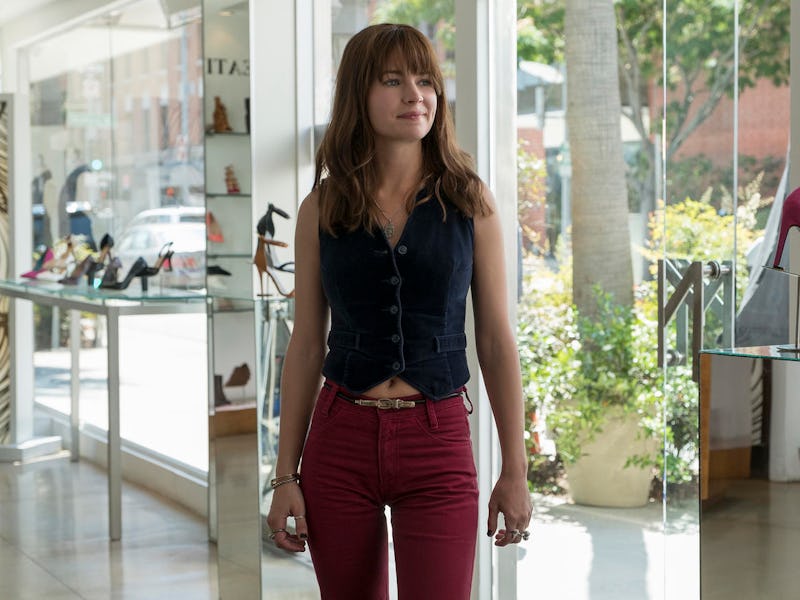The 5 Hard Truths 'Girlboss' Season 2 Needs to Include
Sophia Amoruso's story has plenty of ups and downs to pull from.

The first season of Netflix’s Girlboss follows the story of Sophia Amoruso, the self-made millionaire who founded the online vintage shop Nasty Gal. The show traces the rise of an empire that began in mid-2000s San Francisco, but ignores Amoruso’s fall from grace, which was prompted by some pretty serious accusations of business malpractice and ultimately led to the company’s bankruptcy.
A second season has yet to be announced, but Girlboss series creator Kay Cannon recently told The Hollywood Reporter what she envisioned for a hypothetical second go-round.
“We would see more of her rise,” Cannon said. “It’s unclear if she’d move to L.A. or not, but we’d see some of the bumps of actually being a boss to people. What we’ll do in the show is this idea of understanding what your strengths and weaknesses are.”
Britt Robertson as Sophia Amoruso in Season 1 of Girlboss.
There’s a lot left out of the romanticized interpretation, likely because Amoruso herself served as an executive producer. And it looks like Cannon doesn’t plan on exploring the hard truths in a second season, either. But for the show to be worth watching, it needs to tell the real story, so here are important moments we think the next season should include.
1. Early Hiring and Work Culture Boom
The story of Amoruso’s relationship with her employees will eventually go south, as the former CEO was accused of firing several employees due to their pregnancies. However, for that storyline to work, we’ve also got to see how happy the mainly female workforce at Nasty Gal was before the eventual fall. From its founding in 2006 until around 2013, Nasty Gal seemed exempt from criticism, and was known for offering good health benefits and offices full of free snacks. It’ll be nice to see Britt Robertson’s version of Sophia struggle to deal with managing people, as the real Amoruso did; look no further than the gnarly Glassdoor reviews from former employees for just a few anecdotes.
Sophia Amoruso in 2007.
2. Customer Unrest and Criticism from eBay
One of the early controversies surrounding Nasty Gal was Amoruso’s decision to transition the company from a vintage retail store set up on eBay to a clothing line on an independent website. What gets buried in the retrospectives of that move was that it was a necessary one, after a suspension from eBay that some speculated was connected to the Girlboss “ripping off her customers” with the products she was selling. There are some well-documented allegations of Nasty Gal passing off non-vintage items as the real thing, rigging auctions and other offenses. By the time the suspension was lifted, Amoruso had already moved on to her own site. Some of these early scandals are included in the #GIRLBOSS memoir — from Sophia’s point of view.
Sophia Amoruso in 2016.
3. Transformation into the Girl Boss
The first season of Girlboss features a Sophia that is headstrong but naive as she begins an online vintage store on eBay merely to spite a local shop owner. After Nasty Gal begins to take off, though, we know that the real-life Amoruso underwent a transformation of sorts, and her Cinderella story led to her bestselling memoir #GIRLBOSS in 2015. There was likely a number of attitude adjustments and harsh lessons learned, as well as healthy ego boosts via the droves of magazine covers and hungry reporters flogging her story. There’s certainly the seeds of an egomaniac in Sophia as she’s portrayed in season one, and it would be interesting to see her slowly transition into the full-fledged thing.
4. Moving the Company
Because Nasty Gal expanded so quickly in its early years, an examination of why Amoruso eventually decided to move the company to Los Angeles from San Francisco would be a good opportunity to explore her relationship with the higher-ups at Nasty Gal, as well as her ability to manage a major business move without losing her cool. This would be an especially interesting challenge for the show itself; San Francisco was such a huge character in the first season, and the writers would have to match that sense of importance of location to LA to keep the show tonally consistent.
A Nasty Gal brick and mortar location in Los Angeles.
5. Sophia’s Focus Problem
While season two might be too soon to get to the real meat of Nasty Gal’s downfall, much of the criticism heaped upon Amoruso by employees revolved around her increasing distance from the company in the 18 months before her departure as CEO altogether in early 2015. After Nasty Gal reached a certain height, many Glassdoor reviews indicate that Amoruso became more interested in the press surrounding her image, and then the success of her book, than the company itself.
This would an interesting opportunity to introduce a new character :Sheree Waterson, who would eventually inherit the CEO position when Amoruso stepped down. Waterson, who has a 19% approval rating on Glassdoor right now, has been highly criticized, and blamed with a severe dip in workplace morale. It would be interesting to see how her time with the company slowly allowed Sophia to distance herself from her company.
We’ll see if Netflix opts to continue the Sophia Amoruso story, but there’s plenty of real-life inspiration to fuel a more honest second season if Kay Cannon’s creation moves forward.